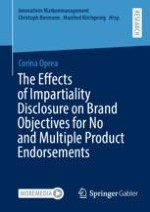2023 | OriginalPaper | Buchkapitel
4. Impartiality Disclosure and Research Gap
verfasst von : Corina Oprea
Erschienen in: The Effects of Impartiality Disclosure on Brand Objectives for No and Multiple Product Endorsements
Verlag: Springer Fachmedien Wiesbaden
Aktivieren Sie unsere intelligente Suche, um passende Fachinhalte oder Patente zu finden.
Wählen Sie Textabschnitte aus um mit Künstlicher Intelligenz passenden Patente zu finden. powered by
Markieren Sie Textabschnitte, um KI-gestützt weitere passende Inhalte zu finden. powered by
